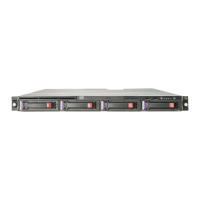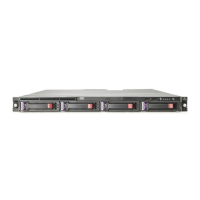S1
S2
S3
S4
B1
B4
B7
B2
B5
B8
B11B10 B12
B6
B3
B9
Figure 5 RAID 0 (data striping) (S1-S4) of d ata blocks (B1-B12)
For data in the array to be readable, the data block sequence within
each stripe must be the same. This sequencing process is performed by
the array controller, which sends the data blocks to the drive write heads
in the correct order.
A natural consequence of the striping process is that each hard drive in a
given array contains the same number of data blocks.
NOTE:
If one hard drive has a larger capacity than other hard drives in the
same array, the extra capacity is wasted because it cannot be used by
the array.
Fault tolerance
Drive failure, although rare, is potentially catastrophic. For example, using
simple striping as shown in Figure 5, failure of any hard drive leads to
failure of all logical drives in the same array, and h ence to data loss.
To protect against data loss from hard drive failure , storage servers should
be configured with fault tolerance. HP recommends adhering to RAID 5
configurations.
The table below summarizes the important features of the different kinds
of R A ID supported by the Smart Array controllers. The decision chart in
34
Storage management overview

